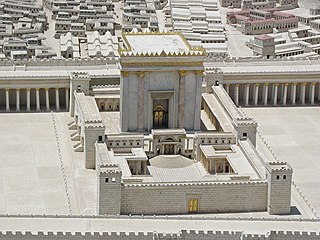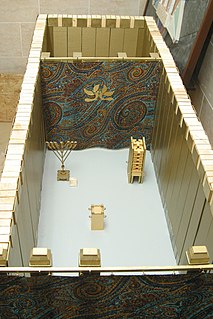
The menorah is a seven-branched candelabrum that is described in the Hebrew Bible as having been used in the Tabernacle and in the Temple in Jerusalem. Since antiquity, it has served as a symbol of the Jewish people and Judaism in both the Land of Israel and the Diaspora; it is depicted on the Israeli national emblem.

The Temple in Jerusalem, or alternatively the Holy Temple, refers to the two now-destroyed religious structures that once served as the central places of worship for the Israelites and Jews on the modern-day Temple Mount of Old Jerusalem. According to the Hebrew Bible, the First Temple was built in the United Kingdom of Israel under Solomon in the 10th century BCE, and was destroyed by the Babylonians in 587 BCE. Following the Persian conquest of Babylon, which ended the Jews' Babylonian captivity, the Second Temple was built as a replacement at the same location around 516 BCE, and was destroyed by the Romans in 70 CE.

Yom Kippur is the holiest day of the year in Judaism. Its central themes are atonement and repentance. Jews traditionally observe this holy day with a day-long fast, confession, and intensive prayer, often spending most of the day in synagogue services. The High Holy Days comprise both Rosh HaShanah and Yom Kippur.

The Second Temple, also known in its later years as Herod's Temple, was the reconstructed Jewish holy temple that stood on the Temple Mount in the city of Jerusalem between c. 516 BCE and 70 CE. It replaced the First Temple that had been destroyed in 587 BCE by the Neo-Babylonian Empire during its conquest of the Kingdom of Judah; the fallen Jewish kingdom was subsequently annexed as a Babylonian province and part of its populace was held captive in Babylon. Construction on the Second Temple began some time after the conquest of Babylon by the Achaemenid Persian Empire, following a proclamation by the Persian king Cyrus the Great that enabled the Jewish return to Zion. The completion of the Second Temple in the new Achaemenid province of Yehud marked the beginning of the Second Temple period in Jewish history.

Myrrh is a gum-resin extracted from a number of small, thorny tree species of the genus Commiphora. Myrrh resin has been used throughout history as a perfume, incense and medicine. Myrrh mixed with posca or wine was common across ancient cultures, for general pleasure, and as an analgesic.

The Holy of Holies is a term in the Hebrew Bible that refers to the inner sanctuary of the Tabernacle, where God's presence appeared. According to Hebrew tradition, the area was defined by four pillars that held up the veil of the covering, under which the Ark of the Covenant was held above the floor. According to the Hebrew scripture, the Ark contained the Ten Commandments, which were given by God to Moses on Mount Sinai. The Temple in Jerusalem was said to have been built by King Solomon for keeping the Ark.

Kodashim is the fifth of the six orders, or major divisions, of the Mishnah, Tosefta and the Talmud, and deals largely with the services within the Temple in Jerusalem, its maintenance and design, the korbanot, or sacrificial offerings that were offered there, and other subjects related to these topics, as well as, notably, the topic of kosher slaughter of animals for non-sacrificial purposes.
In Judaism, the korban, also spelled qorban or corban, is any of a variety of sacrificial offerings described and commanded in the Torah. The plural form is korbanot, korbanoth or korbans.

Yoma is the fifth tractate of Seder Moed of the Mishnah and of the Talmud. It is concerned mainly with the laws of the Jewish holiday Yom Kippur, on which Jews atone for their sins from the previous year. It consists of eight chapters and has a Gemara ("Completion") from both the Jerusalem Talmud and the Babylonian Talmud.
Keritot is a tractate of the Mishnah and Babylonian Talmud. It is the seventh tractate in the Order of Kodashim. Its name is the plural of the punishment kareth which the Torah specifies for intentional violation of certain sins; unintentional violation of the same sins obligates one to bring a sin-offering instead.
Tamid is the ninth tractate in the Order of Kodashim, which is the fifth of the six orders of the Mishnah, Tosefta and the Talmud. The main subject of Tamid is the morning and evening burnt offerings, but it also deals with other Temple ceremonies. Its full name is "Olat Tamid". The tractate includes information about the Temple Service from sages who had been present at the Temple and witnessed the service. This tractate in the Talmud does not contain disagreements between the sages nor does it have exegetical derivations. It is written as a historical description of the service.
Shemen afarsimon was a prized oil used in antiquity. The ancient Jewish community of Ein Gedi was known for its cultivation of the afarsimon.

The Foundation Stone, or the Noble Rock is the rock at the center of the Dome of the Rock in Jerusalem. It is also known as the Pierced Stone because it has a small hole on the southeastern corner that enters a cavern beneath the rock, known as the Well of Souls.
According to the Talmud, the House of Avtinas was responsible for compounding the ketoret, the incense offered on the Inner Altar in the Temple of Jerusalem.

Tractate Middot is the tenth tractate of Seder Kodashim of the Mishnah and of the Talmud. This tractate describes the dimensions and the arrangement of the Temple Mount in Jerusalem, and the Second Temple buildings and courtyards, various gates, the altar of sacrifice and its surroundings, and the places where the Priests and Levites kept watch in the Temple.
Religious use of incense has its origins in antiquity. The burned incense may be intended as a symbolic or sacrificial offering to various deities or spirits, or to serve as an aid in prayer.

The incense offering in Judaism was related to perfumed offerings on the altar of incense in the time of the Tabernacle and the First and Second Temple period, and was an important component of priestly liturgy in the Temple in Jerusalem.
Altars in the Hebrew Bible were typically made of earth or unwrought stone. Altars were generally erected in conspicuous places. The first altar recorded in the Hebrew Bible is that erected by Noah. Altars were erected by Abraham, by Isaac, by Jacob, by Moses, and by Saul.

Leptadenia pyrotechnica is the botanical name of a desert herb of the family Apocynaceae. It is widespread from Senegal to India. It is known as khimp in Hindi and Urdu, and khipp in Punjabi.
The incense offering, a blend of aromatic substances that exhale perfume during combustion, usually consisting of spices and gums burnt as an act of worship, occupied a prominent position in the sacrificial legislation of the ancient Hebrews.










